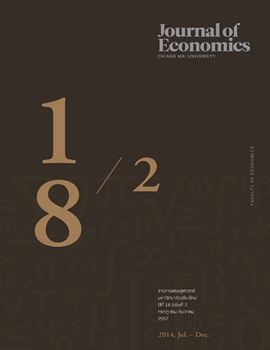การศึกษาปัจจัยที่มีอิทธิพลต่ออุปสงค์รถยนต์ และการพยากรณ์อุปสงค์รถยนต์ในประเทศไทย: กรณีศึกษากลุ่มตลาดรถยนต์นั่งขนาดเล็กและกลุ่มตลาดรถยนต์นั่งกึ่งบรรทุก
คำสำคัญ:
อุปสงค์รถยนต์, การพยากรณ์, แบบจำลอง ARIMA, demand for automobiles forecasting, ARIMA modelบทคัดย่อ
งานวิจัยชิ้นนี้ประกอบด้วยการศึกษาสองส่วน ส่วนแรกผู้วิจัย ศึกษาปัจจัยสำคัญต่างๆ ที่มีอิทธิพลต่ออุปสงค์ยอดขายปลีก รถยนต์ในประเทศไทยโดยการสร้างแบบจำลอง Two-Stage Least Squares ในกรณีนี้ ผู้วิจัยได้เลือกกลุ่มตลาดรถยนต์นั่งขนาดเล็ก และกลุ่มตลาด รถยนต์นั่งกึ่งบรรทุกเป็นกรณีศึกษา ในส่วนที่สอง ผู้วิจัยได้ใช้แบบจำลอง ARIMA สำหรับการพยากรณ์อุปสงค์รถยนต์ในกลุ่มตลาดต่างๆ ข้างต้น เพื่อนำผลการศึกษา ที่ได้มาเป็นข้อมูลสนับสนุนการตัดสินใจด้านการขาย และการตลาด
จากการศึกษาพบว่า ปัจจัยที่มีผลกระทบต่ออุปสงค์รถยนต์ ประกอบด้วย ราคารถยนต์ ในแต่ละกลุ่มตลาด ราคานํ้ามันเชื้อเพลิงซึ่งเป็นสินค้าที่ใช้ประกอบกันกับรถยนต์ ราคา รถยนต์ประเภทอื่นที่ใช้เป็นตัวแทนของราคาสินค้าที่ใช้ทดแทนกัน ค่าใช้จ่ายสำหรับ การโฆษณาในแต่ละกลุ่มตลาด และรายได้ผู้บริโภค ตัวแปรทั้งหมดมีความสัมพันธ์กับ อุปสงค์ยอดขายปลีกแต่ละกลุ่มตลาดอย่างมีนัยสำคัญ และเครื่องหมายค่าสัมประสิทธิ์ ทั้งหมดสอดคล้องกับทฤษฏีอุปสงค์ ในท้ายที่สุด สำหรับการสร้างแบบจำลอง ARIMA เพื่อพยากรณ์อุปสงค์รถยนต์ในแต่ละกลุ่มตลาด ผู้วิจัยพบว่าแบบจำลองที่เหมาะสม สำหรับการพยากรณ์ยอดค้าปลีกรถยนต์นั่งขนาดเล็ก และกลุ่มตลาดรถยนต์นั่งกึ่งบรรทุก ได้แก่ แบบจำลอง SARIMA (2,1,2)x(1,1,0)12 และ แบบจำลอง ARIMA(1,1,1) ตามลำดับ
THE STUDY OF FACTORS INFLUENCING THE AUTOMOTIVE DEMAND AND AUTOMOTIVE DEMAND FORECASTING IN THAILAND: CASE STUDY OF SMALL-CAR AND PICKUP-PASSENGER VEHICLE (PPV) SEGMENTS
This research mainly consists of two parts. In the first part, researchers studied the main factors influencing automotive demand in Thailand by employing the Two-Stage Least Squares models. In this case, researchers selected the retail sales volume of small – car and Pickup – Passenger Vehicle (PPV) segments as the studying case. In the second part of this research, we used the ARIMA models to forecast the automotive demand of the aforementioned segments and using these results to be the decision-support information for sales and marketing decisions.
The results showed that the factors affecting the automotive demand consist of the owned car price of each segment, fuel price representing the price of complementary goods, other car prices as the price of substituted goods, advertising expense for each segment and consumer’s income. All of these variables have a significant relationship with the retailed quantity demand of automotive in all studied segments and the sign of all coefficients are consistent with the demand theory. Finally, for the construction of ARIMA model for forecasting automotive demand in each segment, we found that the appropriate models for forecasting the retail sales volume of small – car and Pickup – Passenger Vehicle (PPV) are SARIMA (2,1,2)x(1,1,0)12 and ARIMA(1,1,1), consecutively
ดาวน์โหลด
ฉบับ
ประเภทบทความ
สัญญาอนุญาต
All opinions and contents in the CMJE are the responsibility of the author(s). Chiang Mai University Journal of Economics reserves the copyright for all published materials. Papers may not be reproduced in any form without the written permission from Chiang Mai University Journal of Economics.
ข้อคิดเห็นที่ปรากฏและแสดงในเนื้อหาบทความต่างๆในวารสารเศรษฐศาสตร์มหาวิทยาลัยเชียงใหม่ ถือเป็นความเห็นและความรับผิดชอบโดยตรงของผู้เขียนบทความนั้นๆ มิใช่เป็นความเห็นและความรับผิดชอบใดๆของวารสารเศรษฐศาสตร์ มหาวิทยาลัยเชียงใหม่
บทความ เนื้อหา และข้อมูล ฯลฯ ในวารสารเศรษฐศาสตร์มหาวิทยาลัยเชียงใหม่ ถือเป็นลิขสิทธิ์เฉพาะของคณะเศรษฐศาสตร์มหาวิทยาลัยเชียงใหม่ หากบุคคลหรือหน่วยงานใดต้องการนำทั้งหมดหรือส่วนหนึ่งส่วนใดไปเผยแพร่ต่อหรือเพื่อกระทำการใดๆ จะต้องได้รับอนุญาตเป็นลายลักษณ์อักษร จากวารสารเศรษฐศาสตร์ มหาวิทยาลัยเชียงใหม่






